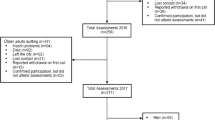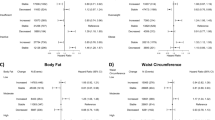Abstract
OBJECTIVE:
To examine the associations of abdominal fat and obesity with functional limitations and disability in late adulthood.
DESIGN:
Longitudinal, cohort study.
PARTICIPANTS:
African American and white men and women aged 45–64 y at baseline with measured waist circumference, waist-to-hip ratio (WHR), and body mass index (BMI) who participated in the Atherosclerosis Risk in Communities (ARIC) Study (n=9416).
OUTCOME MEASURES:
Self-reported functional limitations, activities of daily living (ADLs), and instrumental activities of daily living (IADLs) at ages 52–75 y.
RESULTS:
Waist circumference, WHR, and BMI were positively associated with functional limitations and ADL and IADL impairment approximately 9 y later among African American and white men and women. For example, in African American women the odds ratios (95% CI) associated with a one standard deviation (s.d.) increment in waist circumference (13.3 cm) for severe functional limitations and ADL and IADL impairment were 2.36 (2.00–2.79), 1.41 (1.25–1.58), and 1.49 (1.34–1.66), respectively. In white women, the odds ratios (95% CI) were 2.66 (2.39–2.96), 1.60 (1.47–1.74), and 1.42 (1.31–1.53), respectively. Similar associations were found in men. A 1 s.d. increment in WHR (0.08 U) and BMI (5.06 kg/m2) produced similar results. The associations of waist circumference and WHR with functional limitations and ADL and IADL impairment were attenuated but, in general, remained statistically significant when BMI was added to the models.
CONCLUSIONS:
Maintaining a healthy body weight and avoiding increases in abdominal fat should be investigated for their potential to reduce the risk of functional limitations and disability in an aging population.
This is a preview of subscription content, access via your institution
Access options
Subscribe to this journal
Receive 12 print issues and online access
$259.00 per year
only $21.58 per issue
Buy this article
- Purchase on Springer Link
- Instant access to full article PDF
Prices may be subject to local taxes which are calculated during checkout


Similar content being viewed by others
References
LaCroix AZ, Guralnik JM, Berkman LF, Wallace RB, Satterfield S . Maintaining mobility in late life: smoking, alcohol consumption, physical activity, and body mass index. Am J Epidemiol 1993; 137: 858–869.
Launer LJ, Harris T, Rumpel C, Madans J . Body mass index, weight change, and risk of mobility disability in middle-aged and older women: the Epidemiologic Follow-up Study of NHANES I. JAMA 1994; 271: 1093–1098.
Clark DO, Stump TE, Wolinsky FD . Predictors of onset and recovery from mobility difficulty among adults aged 51-61 years. Am J Epidemiol 1998; 148: 63–71.
Jensen GL, Friedmann JM . Obesity is associated with functional decline in community-dwelling rural older persons. J Am Geriatr Soc 2002; 50: 918–923.
Ostbye T, Taylor DH, Krause KM, van Scoyoc L . The role of smoking and other modifiable lifestyle risk factors in maintaining and restoring lower body mobility in middle-aged and older Americans: results from the HRS and AHEAD. J Am Geriatr Soc 2002; 50: 691–699.
Ferraro KF, Su YP, Gretebeck RJ, Black DR, Badylak SF . Body mass index and disability in adulthood: a 20-year panel study. Am J Public Health 2002; 92: 834–840.
Daviglus ML, Liu K, Yan LL, Pirzada A, Garside DB, Schiffer L, Dyer AR, Greenland P, Stamler J . Body mass index in middle age and health-related quality of life in older age. Arch Intern Med 2003; 163: 2448–2455.
Rossner S . Obesity in the elderly—a future matter of concern? Obes Rev 2001; 2: 183–188.
National Institutes of Health. Clinical guidelines on the identification, evaluation, and treatment of overweight and obesity in adults. Obes Res 1998; 6 (Suppl 2): 51s–209s.
Rexrode KM, Carey VJ, Hennekens CH, Walters EE, Colditz GA, Stampfer MJ, Willett WC, Manson JE . Abdominal adiposity and coronary heart disease in women. JAMA 1998; 280: 1843–1848.
Folsom AR, Stevens J, Schreiner PJ, McGovern PG . Body mass index, waist/hip ratio, and coronary heart disease incidence in African Americans and whites. Atherosclerosis Risk in Communities Study Investigators. Am J Epidemiol 1998; 148: 1187–1194.
Rimm EB, Stampfer MJ, Giovannucci E, Ascherio A, Spiegelman D, Colditz GA, Willett WC . Body size and fat distribution as predictors of coronary heart disease among middle-aged and older US men. Am J Epidemiol 1995; 141: 1117–1127.
Carey VJ, Walters EE, Colditz GA, Solomon CG, Willett WC, Rosner BA, Speizer FE, Manson JE . Body fat distribution and risk of non-insulin-dependent diabetes mellitus in women: the Nurses' Health Study. Am J Epidemiol 1997; 145: 614–619.
Han TS, Tijhuis MAR, Lean MEJ, Seidell JC . Quality of life in relation to overweight and body fat distribution. Am J Public Health 1998; 88: 1814–1820.
Lean MEJ, Han TS, Seidell JC . Impairment of health and quality of life in people with large waist circumference. Lancet 1998; 351: 853–856.
Sternfeld B, Ngo L, Satariano WA, Tager IB . Associations of body composition with physical performance and self-reported functional limitation in elderly men and women. Am J Epidemiol 2002; 156: 110–121.
Ensrud KE, Nevitt MC, Yunis C, Cauley JA, Seeley DG, Fox KM, Cummings SR . Correlates of impaired function in older women. J Am Geriatr Soc 1994; 42: 481–489.
Chen H, Bermudez OI, Tucker KL . Waist circumference and weight change are associated with disability among elderly Hispanics. J Gerontol 2002; 57A: M19–M25.
Bannerman E, Miller MD, Daniels LA, Cobiac L, Giles LC, Whitehead C, Andrews GR, Crotty M . Anthropometric indices predict physical function and mobility in older Australians: the Australian Longitudinal Study of Ageing. Public Health Nutr 2002; 5: 655–662.
Blackwell DL, Tonthat L . Summary health statistics for the US population: National Health Interview Survey, 1997. Vital Health Stat 2002; 10: 1–92.
Ostchega Y, Harris TB, Hirsch R, Parsons VL, Kington R . The prevalence of functional limitations and disability in older persons in the US: data from the National Health and Nutrition Examination Survey III. J Am Geriatr Soc 2000; 48: 1132–1135.
Clark DO, Mungai SM . Distribution and association of chronic disease and mobility difficulty across four body mass index categories in African American women. Am J Epidemiol 1997; 145: 865–875.
Clark DO, Callahan CM, Mungai SM, Wolinsky FD . Physical function among retirement-aged African American men and women. Gerontol 1996; 36: 322–331.
Keil JE, Gazes PC, Sutherland SE, Rust PF, Branch LG, Tyroler HA . Predictors of physical disability in elderly Blacks and Whites of the Charleston Heart Study. J Clin Epidemiol 1989; 42: 521–529.
Houston DK, Stevens J, Cai J, Morey MC . Impact of weight history on functional limitations and disability in late adulthood: the ARIC study. Obes Res (in press).
ARIC Investigators. The Atherosclerosis Risk in Communities (ARIC) Study: design and objectives. Am J Epidemiol 1989; 129: 687–702.
Jackson R, Chambless L, Yang K . Differences between respondents and nonrespondents in a multicenter community-based study vary by gender and ethnicity. J Clin Epidemiol 1996; 49: 1441–1446.
Baecke J, Burema J, Frijters J . A short questionnaire for the measurement of habitual physical activity in epidemiological studies. Am J Clin Nutr 1982; 36: 936–942.
Stokes ME, Davis CS, Koch GG . Categorical Data Analysis Using the SAS System, 2nd edn. SAS Institute, Inc.: Cary, NC; 2000.
Woo J, Ho SC, Sham A . Longitudinal changes in body mass index and body composition over 3 years and relationship to health outcomes in Hong Kong Chinese age 70 and older. J Am Geriatr Soc 2001; 49: 737–746.
Acknowledgements
We thank the staff and participants in the ARIC Study for their important contributions. This study was supported in part by the National Institute on Aging (1 R03 AG022062-01). Denise K Houston is now a Research Associate in the Department of Internal Medicine, Section on Gerontology and Geriatric Medicine, Wake Forest University School of Medicine, Winston-Salem, North Carolina, USA.
Author information
Authors and Affiliations
Corresponding author
Rights and permissions
About this article
Cite this article
Houston, D., Stevens, J. & Cai, J. Abdominal fat distribution and functional limitations and disability in a biracial cohort: the Atherosclerosis Risk in Communities Study. Int J Obes 29, 1457–1463 (2005). https://doi.org/10.1038/sj.ijo.0803043
Received:
Accepted:
Published:
Issue Date:
DOI: https://doi.org/10.1038/sj.ijo.0803043
Keywords
This article is cited by
-
Higher abdominal adiposity is associated with higher lean muscle mass but lower muscle quality in middle-aged and older men and women: the Framingham Heart Study
Aging Clinical and Experimental Research (2023)
-
Visceral fat area is the measure of obesity best associated with mobility disability in community dwelling oldest-old Chinese adults
BMC Geriatrics (2021)
-
Association between adiposity and disability in the Lc65+ cohort
The Journal of nutrition, health and aging (2017)
-
Joint association of obesity and hypertension with disability in the elderly—A community-based study of residents in Shanghai, China
The Journal of nutrition, health and aging (2017)
-
Vascular Risk Factor Burden, Atherosclerosis, and Functional Dependence in Old Age: A Population-Based Study
International Journal of Behavioral Medicine (2014)



